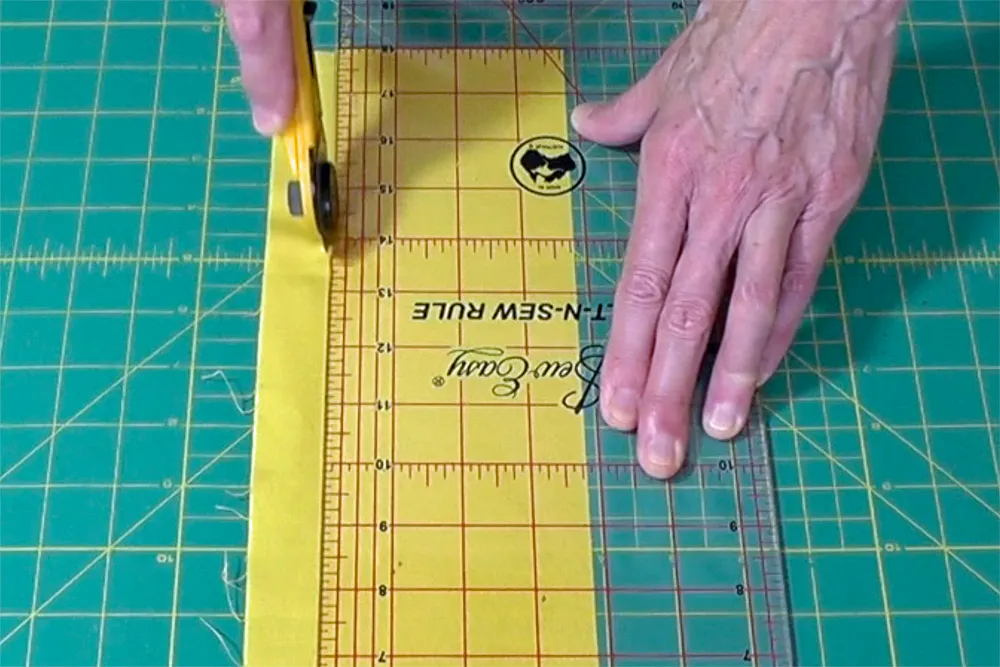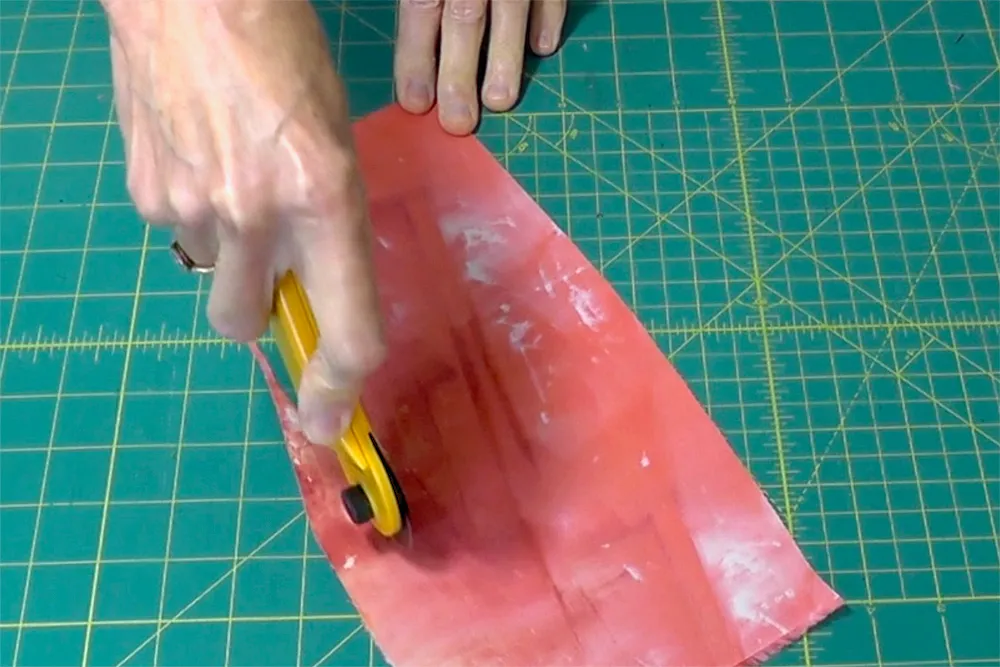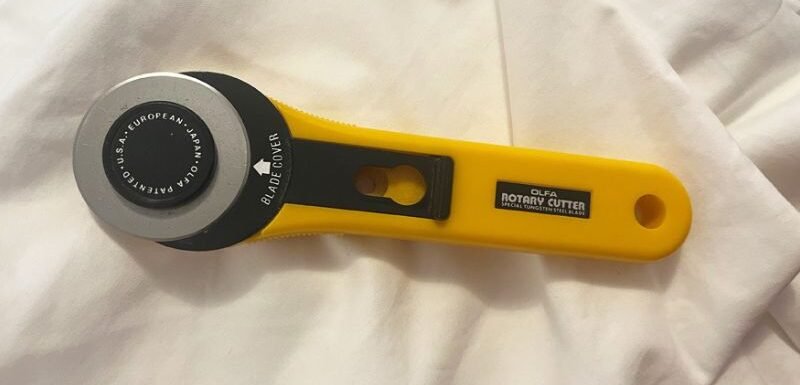Post updated for 2025.
Explore our comprehensive guide to the best rotary cutters for quilters in 2025. Discover different types, top brands, and cutting techniques to enhance your quilting experience.
The invention of the rotary cutter for quilters has revolutionised the quilting world. Since its introduction in 1979 by Olfa, the rotary cutter has become one of the most popular tools for preparing and cutting fabric for quilting.
This comprehensive guide will help you understand how rotary cutters are used and how to choose the best design for your needs.
Best Rotary Cutters for Quilters in 2025
Affiliate Disclosure: Some of the links on this site are affiliate links. This means I may receive a small commission (at no further expense to you) if you click through and make a purchase. ThreadSketchingInAction.com is a participant in the Amazon Services LLC Associates Program, an affiliate advertising program designed to provide a means for sites to earn commission fees by advertising and linking to Amazon.com.
- What are Rotary Cutters and What are They For?
- History of the Rotary Cutter
- Types of Rotary Cutters for Quilters
- Choosing the Right Rotary Cutter for Your Quilting Needs
- The 5 Best Rotary Cutters for Quilters
- Cutting Techniques Using Rotary Cutters
- Ergonomic Rotary Cutters for Quilters
- Safety Tips for Using Rotary Cutters
- Rotary Cutter Accessories for Quilters
- Frequently Asked Questions About Rotary Cutters for Quilting
- Related Articles
What are Rotary Cutters and What are They For?
Rotary cutters are essential tools in a quilter’s arsenal. Resembling a pizza cutter, these tools have a circular blade attached to a handle and are used for cutting fabric.
They’re perfect for precision cutting for traditional quilting and freestyle cutting for art quilting and textile arts.
Rotary cutters offer a clean cut and are easy to handle when cutting multiple layers of fabric or intricate shapes, making them an invaluable tool for quilters.
History of the Rotary Cutter
When Olfa released the first rotary cutter in 1979, it was primarily used for garment making. However, it wasn’t long before quilters discovered these fabulous tools.
In a world before the rotary cutter, tailors, dressmakers, and quilters used templates when preparing pieces for their projects.
Using marking chalk, they traced each shape onto the wrong side of the fabric, then cut them out using regular sewing scissors, adding a 1/4″ seam allowance around the edge.
But when the rotary cutter emerged, more accurate and faster cutting was possible with ordinary scissors, along with the bonus that they reduced strain or fatigue on the user’s hands.
The first rotary cutters were simple, short-handled tools, with a circular blade mounted on the end. This style is still popular today.
Over the years, the designs were refined and improved, and many varieties of cutters are available today.
Types of Rotary Cutters for Quilters
The best rotary cutters for quilters come in various sizes and types. Common types include:
Straight Blade Cutters
These are the most common type, perfect for straight lines and broad curves. They are inexpensive and will last for years is treated with care.
Keep a supply of replacement blades on hand because working with a dull or damaged blade will result in poor fabric cuts and, possibly, damage to your cutting mat.
Decorative Blade Cutters
Several types of decorative blade cutters are available — each type serves a different purpose and enhances a quilter’s creativity and efficiency.
Pinking Cutters
These sharp blades are designed for cutting decorative zigzag edges on fabric, fleece, paper, and more. They’re perfect for scrapbooking, sewing, quilting, card making, and other crafts.
Wave Cutters
They cut a wavy pattern, adding decorative edges to your fabric. They are ideal for cutting quilting fabric, wool, felt, vinyl, leather, cardboard, and more.
Scallop Cutters
The scallop blade cuts a decorative scallop edge on one side and a peak edge on the reverse edge.
Choosing the Right Rotary Cutter for Your Quilting Needs
Selecting the best rotary cutter depends on your quilting style and the projects you undertake.
The most commonly used cutter is undoubtedly the one with the 45mm blade, with all rotary cutters being defined by the diameter of the blade. Sizes available include:
18mm and 28mm Rotary Cutters
These small cutters, available in a few different sizes, are perfect for making precise cuts on intricate pieces or trimming edges.
45mm Rotary Cutter – Most Popular
If you only invest in one rotary cutter, choose one with a 45mm blade. This is known as the ‘standard’ size, is perfect for most quilting purposes, and replacement blades are always easy to source.
Affiliate link
60mm Rotary Cutter
The larger 60mm blade handles thick fabric and multiple layers with ease. It’s also used by crafters who regularly cut card stock.
However, remember that cutting cardboard will dull the edge more rapidly than fabric. Hence, it’s advisable to have dedicated rotary cutters for card and fabric.
Look at the handle design for comfort and control, and consider safety features like blade guards. Evaluate the ease of changing blades, and if you’re left-handed, make sure the cutter is suitable or adjustable for left-hand use.
The 5 Best Rotary Cutters for Quilters
Here is a list of my 5 best rotary cutters for quilters (in no particular order).
Olfa Quick Change Rotary Cutter (45mm)
The Olfa Quick Change Rotary Cutter may look simple, however, it features a comfortable ergonomic handle that’s contoured for comfortable cutting with finger grooves incorporated to prevent finger slippage. It also has a handy hang-hole for easy storage.
Fiskars Classic Comfort Loop Rotary Cutter (45mm)
The Fiskars Classic Comfort Loop Rotary Cutter has a curved, loop handle design and a sliding button extending the blade during use.
Fiskars Titanium Comfort Loop Rotary Cutter (60mm)
Designed for reducing wrist fatigue, the Fiskars 60mm Titanium Loop cutter will cut through batting and multiple fabric layers.
Clover Soft Cushion Rotary Cutter (45mm)
The Clover Soft Cushion Rotary Cutter features a soft cushion handle, which provides a comfortable grip. It also has a manual retractable blade cover.
Kai Rotary Cutter (45mm)
The simple, yet elegant Kai 45mm Rotary Cutter features a natural hand grip and pressure-sensitive blade. It also has a universal grip for right or left-handed use, and most brands of rotary cutter blades will fit the Kai rotary cutters.
Cutting Techniques Using Rotary Cutters
Mastering proper cutting techniques can optimise your use of rotary cutters, and the longevity of your cutter and self-healing cutting mat.
Cutting Straight Edges
align your fabric with a quilting ruler, hold the cutter at a 90-degree angle and exert even pressure as you roll the blade away from your body.
- Hold the ruler with your free hand, keeping your fingers well away from the blade.
- Hold the rotary cutter so that the blade sits neatly against the side of the ruler, at right angles to the edge of the ruler.
- If the blade is angled or leaning, your cut edge may not be even.

Cutting Curved Edges
For curves, move slowly and adjust your cutter’s direction gently. Remember to keep the blade as upright as possible to prevent damage to your cutting mat.
Free-cutting fabric is ideal when creating collages or layers for any type of art quilting or textile art.

Always use a self-healing cutting mat to protect your workspace and enhance the cutter’s performance.
Ergonomic Rotary Cutters for Quilters
Ergonomic rotary cutters, designed to minimise hand and wrist strain, are a smart choice for quilters who often undertake large projects.
They usually feature cushioned handles, a balanced design for stability, and, sometimes, a spring-action blade that reduces hand fatigue.
Excellent ergonomic rotary cutters include:
Safety Tips for Using Rotary Cutters
- Rotary cutters are extremely sharp and need to be handled with care.
- Always use a self-healing cutting mat to protect your workspace.
- Keep your fingers away from the blade, and make sure to retract or cover the blade when the cutter is not in use.
- Store the rotary cutter safely out of children’s reach.
Tip!
If you are working with children, make sure they understand how to handle and use a rotary cutter correctly, and have them wear close-fitting safety cut-resistant gloves on both hands.
Rotary Cutter Accessories for Quilters
Enhance your use of rotary cutters with these essential accessories.
- Self-healing cutting mats protect your workspace and prolong your cutter’s blade life.
- Quilting rulers and templates help ensure precise cuts.
- Replacement blades are also essential – keeping them at hand means you’re always ready for smooth, accurate cutting.
- Cut-resistant gloves are available for both adults and children.
Frequently Asked Questions About Rotary Cutters for Quilting
Q1: Why should I use a rotary cutter instead of scissors for quilting?
A: Rotary cutters offer a cleaner, more precise cut than scissors, especially for straight lines or multiple layers of fabric. They are also easier to handle for extended periods, reducing hand fatigue.
Q2: What’s the difference between a straight blade and a decorative blade rotary cutter?
A: A straight blade rotary cutter cuts clean, straight lines, ideal for most quilting projects. Decorative blades, like pinking or wave cutters, cut patterns into the fabric, reducing fraying or adding decorative edges.
Q3: How often should I replace the blade on my rotary cutter?
A: Blade life varies depending on use and the materials cut. However, a good rule of thumb is to replace it when you notice it no longer cuts cleanly and smoothly.
Q4: How can I safely store my rotary cutter?
A: Always retract the blade or use the safety cover when not in use. Store it in a dry place to prevent rusting, and keep it out of the reach of children.
Q5: Can I use a rotary cutter if I’m left-handed?
A: Yes, many rotary cutters have ambidextrous designs or can be adjusted for left-handed use. Always check the product description before purchasing.
Q6: What size rotary cutter is best for quilting?
A: This largely depends on the projects you work on. Larger blades (45-60mm) are best for cutting multiple fabric layers, while smaller blades (18-28mm) offer precision for intricate patterns.
Q7: What are some necessary rotary cutter accessories for quilting?
A: A self-healing cutting mat and quilting rulers are essential accessories. The mat protects your workspace, prolongs blade life, and rulers help ensure accurate cuts.






